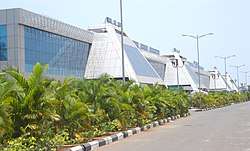Kozhikode
Kozhikode ([koːɻikːoːɖ] (![]()
Kozhikode Calicut | |
|---|---|
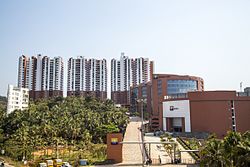  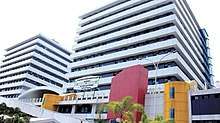  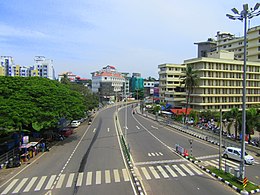   Clockwise from top: Calicut beach skyline, KSRTC bus stand complex, Calicut mini bypass, Kakkayam Valley, Kozhikode Beach, IIM Kozhikode, Hilite Mall. | |
| Nickname(s): | |
 Kozhikode  Kozhikode | |
| Coordinates: 11.25°N 75.77°E | |
| Country | |
| State | Kerala |
| District | Kozhikode |
| Government | |
| • Type | Municipal corporation |
| • Body | Kozhikode Muncipal Corporation |
| • Mayor | Thottathil Raveendran (CPI (M)[4] |
| • Collector | Sri.Sriram Sambasiva IAS[5] |
| • Member of Parliament | M. K. Raghavan (Indian National Congress) |
| Area | |
| • Metropolis | 118 km2 (46 sq mi) |
| • Metro | 518 km2 (200 sq mi) |
| Elevation | 1 m (3 ft) |
| Population (2011) | |
| • Metropolis | 609,224 |
| • Density | 5,200/km2 (13,000/sq mi) |
| • Metro | 2,028,399 |
| • Kozhikode Municipal Corporation | 609,224 [6] |
| Languages | |
| • Official | Malayalam, English |
| Time zone | UTC+5:30 (IST) |
| PIN | 673 xxx |
| Telephone code | 91 (0)495 , 496 |
| Vehicle registration | KL 11, KL 18, KL 56, KL 57, KL 76, KL 77, KLD, KLZ (Old) |
| Sex ratio | 1.093 ♀/♂[8] |
| Literacy | 96.8%[8] |
| Website | www |
During classical antiquity and the Middle Ages, Kozhikode was dubbed the City of Spices for its role as the major trading point of Indian spices.[1] A historical city, it was the capital of an independent kingdom ruled by the Samoothiris (Zamorins) in the Middle Ages. According to data compiled by economics research firm Indicus Analytics in 2009 on residences, earnings and investments, Kozhikode ranked as the second best city in India to reside in.[10]
Etymology
The exact origin of the name Kozhikode is uncertain. According to many sources, the name Kozhikode is derived from Koyil-kota (fort), meaning fortified palace.[11] The name also got corrupted into Kolikod, or its anglicized version Calicut.[12]
Arab merchants called it Qāliqūṭ (IPA: qˠaːliqˠːuːtˤ).[13]
Although the city's official name is Kozhikode, in English it is sometimes known by its anglicised version, Calicut.[14] The word calico, a fine variety of hand-woven cotton cloth that was exported from the port of Kozhikode, is thought to have been derived from Calicut.[15] It is the historical capital of Kerala as the history dates back to 1498 AD when Vasco da Gama landed in Kappad, near Calicut.[16]
History
Kozhikode was the capital of an independent kingdom ruled by the samoothiris (Zamorins) in the Middle Ages and later of the erstwhile Malabar District under British rule. Arab merchants traded with the region as early as 7th century, and Portuguese explorer Vasco da Gama landed at Kozhikode on 20 May 1498, thus opening a trade route between Europe and Malabar. A Portuguese factory and the fort was intact in Kozhikode for short period (1511–1525, until the Fall of Calicut). The English landed in 1615 (constructing a trading post in 1665), followed by the French (1698) and the Dutch (1752). In 1765, Mysore captured Kozhikode as part of its occupation of the Malabar Coast. Kozhikode, once a famous cotton-weaving centre, gave its name to the Calico cloth.[17]
It was ranked eleventh among Tier-II Indian cities in job creation by a study conducted by ASSOCHAM in 2007.[18]
Early Kozhikode in foreign accounts
Accounts of the city and the conditions prevailing then can be gleaned from the chronicles of travellers who visited the port city.
Ibn Battuta (1342–1347), who visited six times, gives the earliest glimpses of life in the city. He describes Kozhikode as "one of the great ports of the district of Malabar" where "merchants of all parts of the world are found". The king of this place, he says, "shaves his chin just as the Haidari Fakeers of Rome do... The greater part of the Muslim merchants of this place are so wealthy that one of them can purchase the whole freightage of such vessels put here and fit out others like them".[19]

Ma Huan (1403 AD), the Chinese sailor part of the Imperial Chinese fleet under Cheng Ho (Zheng He)[20] lauds the city as a great emporium of trade frequented by merchants from around the world. He makes note of the 20 or 30 mosques built to cater to the religious needs of the Muslims, the unique system of calculation by the merchants using their fingers and toes (followed to this day) and the matrilineal system of succession.
Abdur Razzak (1442–43) the ambassador of Persian Emperor Sha-Rohk finds the city harbour perfectly secured and notices precious articles from several maritime countries especially from Abyssinia, Zirbad and Zanzibar.
The Italian Niccolò de' Conti (1445), perhaps the first Christian traveller who noticed Kozhikode, describes the city as abounding in pepper, lac, ginger, a larger kind of cinnamon, myrobalans and zedary. He calls it a noble emporium for all India, with a circumference of eight miles (13 km).
The Russian traveller Athanasius Nikitin or Afanasy Nikitin (1468–74) calls 'Calecut' a port for the whole Indian sea and describes it as having a "big bazaar."
Other travellers who visited Kozhikode include the Italian Ludovico di Varthema[21] (1503–1508) and Duarte Barbosa.[22]
The Samoothiri
Kozhikode and its suburbs formed part of the Polanad kingdom ruled by the Porlatiri.[23] The Eradis of Nediyirippu in Eranad wanted an outlet to the sea, to initiate trade and commerce with the distant lands.[24] and after fighting with the king Polatthiri for 48 years conquered the area around Panniankara. After this, Menokki became the ruler of Polanad and came to terms with the troops and people.[25] After this, the town of Kozhikode was founded close to the palace at Tali.[26] Then, the Eradis shifted their headquarters from Nediyirippu to Kozhikode. The Governor of Ernad built a fort at a place called Velapuram to safeguard his new interests. The fort most likely lent its name to Koyil Kotta the precursor to Kozhikode. Thus the city came into existence sometime in the 13th century CE. The status of Udaiyavar increased and he became known as Swami Nambiyathiri Thirumulpad, and eventually Samuri or Samoothiri. Europeans called him in a corrupt form as Zamorin.
According to K.V. Krishna Iyer, the rise of Kozhikode is at once a cause and a consequence of Samoothiri's ascendancy in Kerala. By the end of the century, Samoothiri was at the zenith of his powers with all princes and chieftains of Kerala north of Kochi acknowledging his suzerainty.[27]
Climate
Kozhikode has a tropical monsoon climate (Köppen climate classification Am). A brief spell of pre-monsoon Mango showers hits the city sometime during April. However, the primary source of rain is the South-west monsoon that sets in the first week of June and continues until September. The city receives significant precipitation from the North-East Monsoon that sets in from the second half of October through November.
The average annual rainfall is 3,266 mm. The weather is milder from December/January until March when the skies are clear and the air is crisp. Winters are seldom cold. The highest temperature recorded was 39.4 °C in March 1975. The lowest was 14 °C recorded on 26 December 1975.
| Climate data for Kozhikode (1981–2010, extremes 1901–2012) | |||||||||||||
|---|---|---|---|---|---|---|---|---|---|---|---|---|---|
| Month | Jan | Feb | Mar | Apr | May | Jun | Jul | Aug | Sep | Oct | Nov | Dec | Year |
| Record high °C (°F) | 35.6 (96.1) |
36.6 (97.9) |
36.5 (97.7) |
37.2 (99.0) |
37.2 (99.0) |
35.1 (95.2) |
33.2 (91.8) |
33.2 (91.8) |
34.0 (93.2) |
34.9 (94.8) |
35.2 (95.4) |
35.3 (95.5) |
37.2 (99.0) |
| Average high °C (°F) | 32.2 (90.0) |
32.6 (90.7) |
33.2 (91.8) |
33.6 (92.5) |
32.9 (91.2) |
30.0 (86.0) |
29.0 (84.2) |
29.0 (84.2) |
30.2 (86.4) |
31.1 (88.0) |
31.8 (89.2) |
32.2 (90.0) |
31.5 (88.7) |
| Average low °C (°F) | 22.8 (73.0) |
23.8 (74.8) |
25.4 (77.7) |
26.4 (79.5) |
26.1 (79.0) |
24.3 (75.7) |
23.7 (74.7) |
23.8 (74.8) |
24.1 (75.4) |
24.2 (75.6) |
24.0 (75.2) |
22.9 (73.2) |
24.3 (75.7) |
| Record low °C (°F) | 13.8 (56.8) |
16.1 (61.0) |
19.4 (66.9) |
21.0 (69.8) |
20.0 (68.0) |
20.6 (69.1) |
20.5 (68.9) |
20.6 (69.1) |
21.1 (70.0) |
18.6 (65.5) |
16.1 (61.0) |
16.1 (61.0) |
13.8 (56.8) |
| Average rainfall mm (inches) | 3.1 (0.12) |
3.9 (0.15) |
13.0 (0.51) |
84.3 (3.32) |
242.4 (9.54) |
846.4 (33.32) |
734.4 (28.91) |
412.2 (16.23) |
247.8 (9.76) |
309.5 (12.19) |
133.1 (5.24) |
23.9 (0.94) |
3,053.9 (120.23) |
| Average rainy days | 0.2 | 0.2 | 0.9 | 3.5 | 8.9 | 23.3 | 23.8 | 19.3 | 11.7 | 11.4 | 6.0 | 1.4 | 110.6 |
| Average relative humidity (%) (at 17:30 IST) | 65 | 66 | 69 | 71 | 75 | 85 | 87 | 86 | 82 | 78 | 73 | 65 | 75 |
| Source: India Meteorological Department[28][29] | |||||||||||||
Demographics

Religion in Kozhikode city (2011)[30]
Total Population under Municipal Corporation limits is 550,440.[31] Males form 47.7% and females 52.3%.
Kozhikode has been a multi-ethnic and multi-religious town since the early medieval period. The Hindus form the largest religious group, followed by Muslims and Christians.[32] Hindus form the majority at 60.7% of the population with 315807 members.[31] Muslims form 37.6% of the population with 207298 members.[31]
The corporation of Kozhikode has an average literacy rate of 96.8%[8] (national average is 74.85%). The male literacy rate is 97.93% and female literacy rate is 95.78%.[8]
Pre-modern Kozhikode was already teeming with people of several communities and regional groups. Most of these communities continued to follow their traditional occupations and customs till the 20th century.[33] Brahmins, too, lived in the city mostly around the Hindu temples. Regional groups like the Tamil Brahmins, Gujaratis and Marwari Jains became part of the city and lived around their shrines.[34]
The Nairs formed the rulers, warriors and landed gentry of Kozhikode.[35] The Samoothiri had a ten thousand strong Nair bodyguard called the Kozhikkottu pathinaayiram (The 10,000 of Kozhikode) who defended the capital and supported the administration within the city. He had a larger force of 30,000 Nairs in his capacity as the Prince of Eranadu, called the Kozhikkottu Muppatinaayiram (The 30,000 of Kozhikode).[36] The Nairs also formed the members of the suicide squad (chaver).[37] The Thiyyas formed the vaidyars(Physicians), local militia and traders of Kozhikode.
The Muslims of Kozhikode are known as Mappilas, and according to the official Kozhikode website "the great majority of them are Sunnis following the Shafi school of thought.[32] There are some smaller communities among the Muslims such as Dawoodi Bohras of Gujarati origin.[38] Many of the Muslims living in the historic part of the city follow matrilineality and are noted for their piety.[39] Though Christianity is believed to have been introduced in Kerala in 3rd Century CE, the size of community in Malabar (northern Kerala) began to rise only after the arrival of the Portuguese missionaries towards the close of the 15th century. A few Christians of Thiruvitankoor and Kochi have lately migrated to the hilly regions of the district and are settled there.[39]
The Tamil Brahmins are primarily settled around the Tali Siva temple. They arrived in Kozhikode as dependants of chieftains, working as cooks, cloth merchants and moneylenders.[40] They have retained their Tamil language and dialects as well as caste rituals. The Gujarati community is settled mostly around the Jain temple in and around the Valliyangadi. They owned many establishments, especially textile and sweet shops. They must have arrived in Kozhikode at least from the beginning of the 14th century. They belong to either the Hindu or the Jain community. A few Marwari families are also found in Kozhikode who was basically moneylenders.
Civic administration
The city is administered by the Kozhikode Corporation, headed by a mayor. For administrative purposes, the city is divided into 75 wards,[41] from which the members of the corporation council are elected for five years. Recently neighbouring suburbs Beypore, Elathur, Cheruvannur and Nallalam were merged within the municipal corporation.
| Kozhikode Municipal Corporation | |
|---|---|
| Mayor | Thottathil Raveendran |
| Deputy Mayor | Meera Darsak |
| Member of Parliament | M.K.Raghvan |
| District Collector | Shri. Seeram Sambasiva Rao IAS |
| Police Commissioner | Shri A V George IPS |
Kozhikode Corporation is the first City Corporation in Kerala after the creation of the state. Established in 1962, Kozhikode Corporation's first mayor was H Manjunatha Rao. Kozhikode corporation has four assembly constituencies – Kozhikode North, Kozhikode South, Beypore and Elathur – all of which are part of Kozhikode.[42]
Kozhikode Municipal Corporation Election 2015
| S.No. | Party Name | Party symbol | Number of Corporators |
|---|---|---|---|
| 01 | LDF | 47 | |
| 02 | UDF | 21 | |
| 03 | BJP | 07 | |
| 04 | Independents |  | 0 |
Law and order
The Kozhikode City Police is headed by a commissioner, an Indian Police Service (IPS) officer. The city is divided into six zones each under a circle officer. Apart from regular law and order, the city police comprise the traffic police, bomb squad, dog squad, fingerprint bureau, women's cell, juvenile wing, narcotics cell, riot force, armed reserve camps, district crime records bureau and a women's station.[43] It operates 16 police stations functioning under the Home Ministry of Government of Kerala.
Transport
Road
National highways


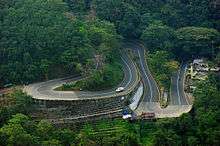


National Highway 66 connects Kozhikode to Mumbai via Mangaluru, Udupi and Goa to the north and Kochi and Kanyakumari near Thiruvananthapuram to the south along the west coast of India. This highway connects the city with the other important towns like, Kasaragod, Kanhangad, Kannur, Thalassery, Mahe, Vadakara, Koyilandy[44] Ramanattukara, Kottakkal, Kuttippuram, Ponnani, Kodungallur, North Paravur, Ernakulam, Edapally and proceeds to Alappuzha, Thiruvananthapuram and terminates at the southern tip of India, Kanyakumari.
National Highway 766 connects Kozhikode to Bangalore through Kollegal in Karnataka via Tirumakudal Narsipur, Mysore, Nanjangud, Gundlupet, Sulthan Bathery, Kalpetta and Thamarassery.
National Highway 966 connects Kozhikode to Palakkad through Malappuram . It covers a distance of 125 kilometres (78 mi). At Ramanattukara, a suburb of Kozhikode, it joins NH 66. It passes through towns like Kondotty, Perinthalmanna, and Mannarkkad and Malappuram. This stretch connects the city and Calicut International Airport.
State Highways
SH 29 passes through the city. It connects NH 212, Malabar Christian College, civil station, Kunnamangalam, Thamarassery, Chellot, Chitragiri and Road to Gudallor from Kerala border.
SH 54 connects the city to Kalpetta. The highway is 99.0 kilometres (61.5 mi) long. The highway passes through Pavangad, Kozhikode, Ulliyeri, Perambra, Poozhithodu, Peruvannamuzhi and Padinjarethara. SH 68 starts from Kappad and ends in Adivaram. The highway is 68.11 kilometres (42.32 mi) long.
SH 34 starts from Koyilandy and ends in Edavanna which is 44.0 km long. This highway passes through Koyilandi, Ulliyeri, Balussery, Thamarassery, Omassery, Mukkam.
Buses
Buses, predominantly run by individual owners, ply on the routes within the city and to nearby locations. City buses are painted green. Kerala State Road Transport Corporation (KSRTC) runs regular services to many destinations in the state and to the neighbouring states. The city has three bus stands. All private buses to the suburban and nearby towns ply from the Palayam Bus Stand. Private buses to adjoining districts start from the Mofussil Bus Stand on Indira Gandhi Road (Mavoor Road). Buses operated by the KSRTC drive from the KSRTC bus stand on Indira Gandhi Road. KSRTC Bus Stand Kozhikode is the largest bus stand in Kerala having a size of 36,036.47 meter square.[45] There are also KSRTC depots in Thamarassery, Thottilpalam, Thiruvambady and Vatakara. There are three routes available to Bangalore. Kozhikode–Sulthan Bathery-Gundlupet–Mysore–Bangalore is the preferred one and is very busy. Another route, is Kozhikode-Manathavady-Kutta-Mysore-Bangalore. The third one, less used, is Kozhikode–Gundlupet–Chamarajanagar–Kollegal–Bangalore.
Private tour operators maintain regular luxury bus services to Mumbai, Bangalore, Coimbatore, Chennai, Vellore, Ernakulam, Trivandrum, Ooty, Mysore. etc. and mainly operate from the Palayam area. These are usually night services.
Rail
The history of railways in Malabar dates to 1861 when the first tracks were laid between Tirur and Beypore.[46]
Air
Calicut International Airport is 26 kilometres (16 mi) from the city at Karipur. Domestic services are operated to major Indian cities.
Economy

Calicut is one of the biggest economic hubs in Kerala. Service sector dominates the economy followed by industries. Cyberpark, a Government of Kerala organisation, plans to build, operate and manage IT parks for the promotion and development of investment in IT and ITES industries in the Malabar region of Kerala. It would be the third IT hub in the state of Kerala. The two IT parks might create a total 100,000 direct job opportunities. The first project is the development of Cyberpark hub in Kozhikode with its spokes at Kannur and Kazargode IT parks.[47][48] Other planned projects include the Birla IT park (at Mavoor) and Malaysian satellite city (at Kinaloor) where KINFRA has plans to set up a 400-acre (1.6 km2) industrial park. In 2012, Kozhikode was given the tag of "City of Sculptures" (Shilpa Nagaram) because of the architectural sculptures around the city.[49][50]
Shopping

The city has a strong mercantile aspect. The main area of business was once Valiyangadi (Big Bazaar) near the railway station. As time progressed, it shifted to other parts of the city. The commercial heart has moved to Mittai Theruvu (Sweetmeat Street or S. M. Street), a long street crammed with shops that sell everything from saris to cosmetics. It also houses restaurants and sweetmeat shops. Today, the city has multiple shopping malls. Focus Mall (First mall of Kerala ), HiLITE Mall[51] Address Mall and RP Mall are a few among them.[52]
Music
In addition to the Malabar Mahotsavam, the annual cultural fest of Kozhikode,[53] every year since 1981 the Tyagaraja Aradhana Trust has been conducting a five-day music festival in honour of Tyagaraja. The festival is complete with the Uncchavritti, rendering of Divyanama kritis, Pancharatna Kritis, concerts by professional artistes and students of music from morning to late in the evening.[54]
Kozhikode has a tradition of Ghazal and Hindustani music appreciation. There are many Malayalam Ghazals. The late film director and play back singer M. S. Baburaj, from Kozhikode was influenced by Ghazal and Hindustani.[55]
Media
Radio
The Kozhikode radio station of All India Radio has two transmitters: Kozhikode AM (100 kilowatts) and Kozhikode FM [Vividh Bharathi] (10 kilowatts). Private FM radio stations are Radio Mango 91.9 operated by Malayala Manorama Co. Ltd. Radio Mirchi operated by Entertainment Network India Ltd. and Club FM 104.8 operated by Mathrubhumi group and Red FM 93.5 of the SUN Network. AIR FM radio stations are Kozhikode – 103.6 MHz; AIR MW radio station is Kozhikode – 684 kHz.
Television
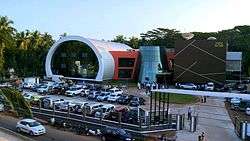
A television transmitter has been functioning in Kozhikode since 3 July 1984, relaying programmes from Delhi and Thiruvananthapuram Doordarshan. Doordarshan has its broadcasting centre in Kozhikode at Medical College. The Malayalam channels based on Kozhikode are the Shalom Television, Darshana TV and Media One TV. All major channels in Malayalam viz. Manorama News, Asianet, Surya TV, Kairali TV, Amrita TV, Jeevan TV, Indiavision and Jaihind have their studios and news bureaus in the city.
Satellite television services are available through DD Direct+, Dish TV, Sun Direct DTH and Tata Sky. Asianet Digital TV is popularly known as ACV telecasts daily city news. Spidernet is another local channel. Other local operators include KCL and Citinet.
The Calicut Press Club came into existence in 1970. It is the nerve centre of all media activities, both print and electronic. Begun with around 70 members in the roll, this Press Club, became a prestigious and alert media centre in the state with a present membership of over 280.[56]
Education
There are 1,237 schools in Kozhikode district including 191 highschools.[57]
Kozhikode is home to two premier educational institutions of national importance: the Indian Institute of Management Kozhikode (IIMK), and the National Institute of Technology, Calicut (NITC). Other institutions include National Institute for Research and Development in Defence Shipbuilding (NIRDESH),[58] Indian Institute of Spices Research (IISR),[59] and National Institute of Electronics and Information Technology (NIELIT) are also based in Calicut.[60]
Recently Kozhikode got Kerala's first residential I.B continuum school, 'The White School International' Located in Perumanna. The school was established in 2016.
The University of Calicut is the largest university in Kerala and is located in Thenjipalam, about 24 kilometres (15 mi) south of Calicut. This university was established in 1968 and was the second university set up in Kerala. Most of the colleges offering tertiary education in the region are affiliated to this university.[61] The Calicut Medical College was established in 1957 as the second medical college in Kerala. Since then, the institution has grown into a premier centre of medical education in the state. Presently it is the largest medical institute in the state with a yearly intake of 250 candidates for the undergraduate programme.
In 1877, a school for young Rajas was started in Kozhikode. This was later thrown open to all caste Hindu boys. In 1879, it was affiliated to the University of Madras as a second-grade college and with this, collegiate education in the district received a fillip. Secondary education recorded appreciable progress since 1915. The erstwhile Malabar district, of which the present Kozhikode district formed a part, holds a high rank among the districts of Madras Presidency in secondary education.[62]
Location
See also
References
- "Lectures 26-27". 16 July 2009. Archived from the original on 16 July 2009. Retrieved 22 June 2019.
- M. G. S. Narayanan (2006). The City of Truth Revisited. University of Calicut. p. 350. ISBN 978-8177481044.
- "Kozhikode to be 'city of sculptures'". The Hindu. 6 June 2012.
- "thottathil-raveendran-new-calicut-mayor". Malayala manorama. Doha, Qatar. 5 June 2016. Archived from the original on 1 July 2016. Retrieved 5 June 2016.
- "District Collectors/ADMs/SPs". Government of Kerala. Archived from the original on 1 May 2012. Retrieved 6 May 2012.
- "ആമുഖം | കോഴിക്കോട് മുനിസിപ്പല് കോര്പ്പറേഷന്". kozhikodecorporation.lsgkerala.gov.in.
- "Urban Agglomerations/Cities having population 1 million and above" (PDF). The Registrar General & Census Commissioner, India. Retrieved 19 November 2011.
- "Provisional Population Totals, Census of India 2011; Cities having population 1 lakh and above" (PDF). Office of the Registrar General & Census Commissioner, India. Retrieved 26 March 2012.
- "Urban Agglomerations/Cities having population 1 million and above" (PDF). Office of the Registrar General & Census Commissioner, India. Archived (PDF) from the original on 15 December 2011.
- "Best cities to live, invest and earn in". Ibnlive.com. Retrieved 23 September 2009. Indicus considered six parameters: health, education, environment, safety, public facilities and entertainment
- Menon, A. Sreedhara (1965). Kerala District Gazetteers: Kozhikode - Gazetteer of India, Volume 5 of Kerala District Gazetteers, Kerala (India). Superintendent of Govt. Presses.
- Ayyar, K. V. Krishna (1938). The Zamorins of Calicut: From the Earliest Times Down to A.D. 1806. Publication Division, University of Calicut; University of Michigan.
- Hermann Kulke, Dietmar Rothermund (2010). "18. Ibn Battuta: International Trade at the Malabar Coast". A History of India. Routledge. ISBN 9780415485432.
Thence we travelled to the town of Qāliqūṭ. [Calicut], which is one of the chief ports in Mulaibār.
- M.G.S. Narayanan, Calicut: The City of Truth (2006) Calicut University Press, Kozhikode.
- Encyclopædia Britannica (2008). calico
- 1951-, Crowley, Roger (2015). Conquerors : how Portugal forged the first global empire (First ed.). New York. ISBN 9780812994001. OCLC 904967943.CS1 maint: numeric names: authors list (link)
- "Kozhikode." Encyclopædia Britannica. 18 November 2011.
- "Archived copy". Archived from the original on 23 July 2011. Retrieved 20 April 2010.CS1 maint: archived copy as title (link)
- Ibn Battuta, H. A. R. Gibb (1994). The Travels of Ibn Battuta A.D 1325-1354. IV. London.
- Ma Huan: Ying Yai Sheng Lan, The Overall Survey of the Ocean's Shores, translated by J.V.G. Mills, 1970 Hakluyt Society, reprint 1997 White Lotus Press. ISBN 974-8496-78-3
- Varthema, Ludovico di, The Travels of Ludovico di Varthema, A.D.1503–08, translated from the original 1510 Italian ed. by John Winter Jones, Hakluyt Society, London
- Gangadharan. M., The Land of Malabar: The Book of Barbosa (2000), Vol II, M.G University, Kottayam.
- Sreedhara Menon.A, A Survey of Kerala History(1967), p.152. D.C.Books Kottayam
- Bhāratīya sthalanāma patrikā (page 44) published by Place Names Society of India
- Sewell, Robert (1884). Lists of inscriptions, and sketch of the dynasties of southern India. E. Keys at the Government Press. p. 197.
The Samoothiri made Menokki ruler of Porallatiri and came to terms with the troops and people. After this follows an account of the founding of the town of Kozhikode, close to the Samoothiri's palace at Tali
- K. V. Krishna Ayyar; University of Calicut. Publication Division (1938). The Samorins of Calicut: from the earliest times down to A.D. 1806. Publication Division, University of Calicut. p. 82. ISBN 978-81-7748-000-9. Retrieved 25 July 2011.
- "Kozhikode (Calicut), Kerala, India - Kozhikode (Calicut) Hotels, Kozhikode (Calicut) resorts, Kozhikode (Calicut) tourism, Kozhikode (Calicut) real estate and Kozhikode (Calicut) businesses". Kozhikode.com. Retrieved 22 June 2019.
- "Station: Calikote / Kozhicode Climatological Table 1981–2010" (PDF). Climatological Normals 1981–2010. India Meteorological Department. January 2015. pp. 165–166. Archived from the original (PDF) on 5 February 2020. Retrieved 19 February 2020.
- "Extremes of Temperature & Rainfall for Indian Stations (Up to 2012)" (PDF). India Meteorological Department. December 2016. p. M108. Archived from the original (PDF) on 5 February 2020. Retrieved 19 February 2020.
- "Religion – Kerala, Districts and Sub-districts". Census of India 2011. Office of the Registrar General.
- "C -1 POPULATION BY RELIGIOUS COMMUNITY - 2011" (XLS). Censusindia.gov.in. Retrieved 22 June 2019.
- "Official Website of Kozhikode". Kkd.kerala.gov.in. 26 December 1975. Archived from the original on 12 October 2009. Retrieved 23 September 2009.
- "Official website of kozhikode". 12 October 2009. Archived from the original on 12 October 2009.
- Narayanan M.G.S., Calicut: The City of Truth, Calicut University Press (2006)
- Nossiter, Thomas Johnson (1 January 1982). Communism in Kerala: A Study in Political Adaptation. University of California Press. p. 25. ISBN 978-0-520-04667-2.
- Narayanan, M. G. S. (2006). Calicut: The City of Truth Revisited. University of Calicut. p. 112. ISBN 978-81-7748-104-4.
- Prange, Sebastian R. (3 May 2018). Monsoon Islam: Trade and Faith on the Medieval Malabar Coast. Cambridge University Press. ISBN 978-1-108-42438-7.
- "Bohras in Calicut". Hinduonnet.com. 19 May 2006. Archived from the original on 3 July 2009. Retrieved 23 September 2009.
- "Official website of Kozhikode, Govt. of Kerala". Kkd.kerala.gov.in. 26 December 1975. Archived from the original on 12 October 2009. Retrieved 23 September 2009.
- Narayanan.M.G.S., Calicut: The City of Truth(2006) Calicut University Publications
- "Kozhikode Corporation, Councillors" (PDF). Kozhikodecorporation.org. Retrieved 27 November 2011.
- Kozhikode Lok Sabha constituency redrawn Delimitation impact, The Hindu 5 February 2008
- "Kozhikode City Police". Kozhikode City Police. Archived from the original on 8 February 2012. Retrieved 27 November 2011.
- "Deadlock on Pooladikunnu-Vengalam stretch over". The New Indian Express. Retrieved 22 June 2019.
- "Archived copy". Archived from the original on 18 June 2018. Retrieved 18 June 2018.CS1 maint: archived copy as title (link)
- "Central station completes 75 years". The Hindu. Chennai, India. 5 November 2006.
- "Kozhikode - Cyber Park Kerala". Cyberparkkerala.org. Retrieved 22 June 2019.
- "Kozhikode Cyberpark to take off next year". Archived from the original on 12 February 2010.
- "'Shilpa Nagaram' on June 7". The Hindu. Chennai, India. 4 June 2012.
- "Kozhikode is 'Shilpa Nagaram'". The Hindu. Chennai, India. 8 June 2012.
- "Archived copy". Archived from the original on 18 June 2018. Retrieved 18 June 2018.CS1 maint: archived copy as title (link)
- "HiLITE City, One of India's Largest Mixed-Use Development Project Enters the Limelight". Business Wire. 9 March 2015. Retrieved 4 September 2015.
- "Malabar Mahotsavam set for a comeback". The Hindu. 1 January 2010. Retrieved 4 September 2015.
- "Paying tribute to Sathguru Sri Tyagaraja". Tyagaraja Aradhana Trust. Retrieved 4 September 2015.
- Ramin Raveendran (20 October 2013). "Keeping the harmonium close to his heart". The New Indian Express. Retrieved 4 September 2015.
- "Calicut press club". Archived from the original on 23 June 2003.
- List of High Schools in Kozhikode, Mighil 28 December 2017
- Biju Govind (1 May 2016). "Nirdesh to design ships for Navy". The Hindu. Calicut, India. Retrieved 21 May 2019.
- "History". Indian Institute of Spices Research. Retrieved 21 May 2019.
- "Introduction". National Institute of Electronics and Information Technology. Retrieved 21 May 2019.
- "About". University of Calicut. Retrieved 21 May 2019.
- "Kozhikode Education". Archived from the original on 5 February 2012. Retrieved 18 December 2018.
External links
| Wikimedia Commons has media related to Kozhikode. |
| Wikiquote has quotations related to: Kozhikode |
![]()
